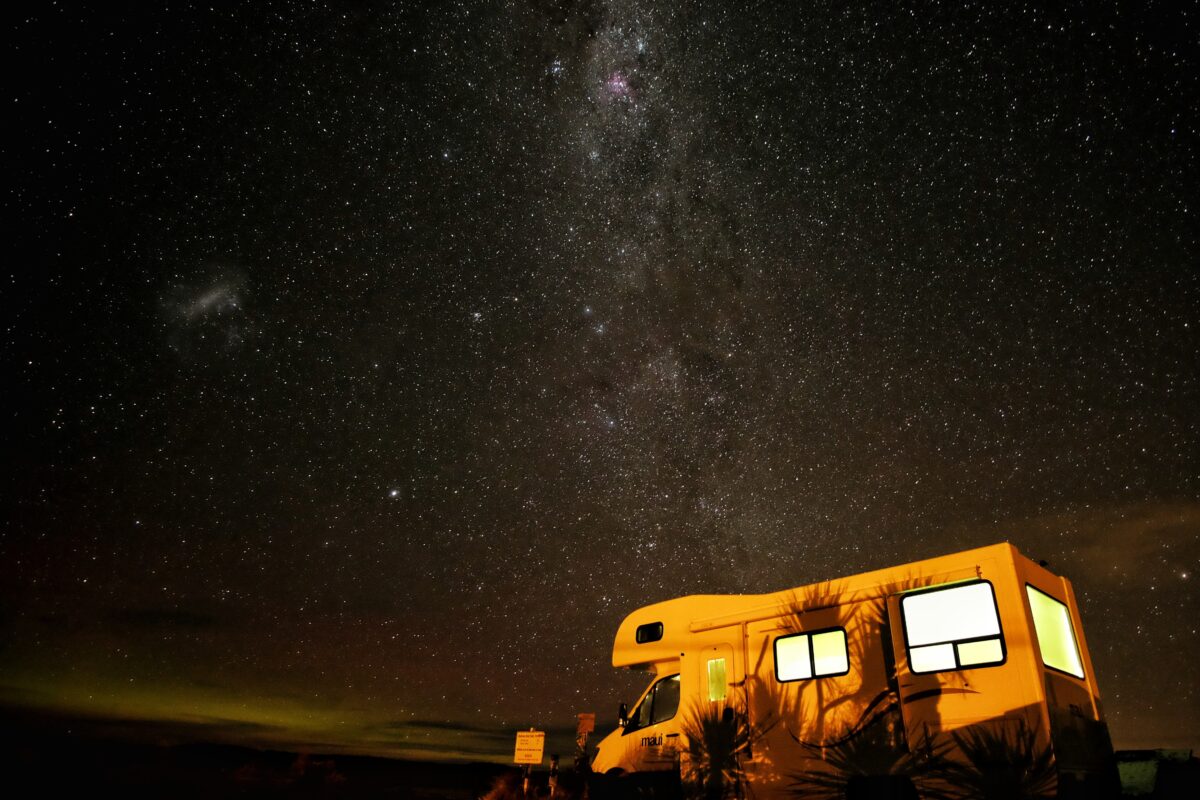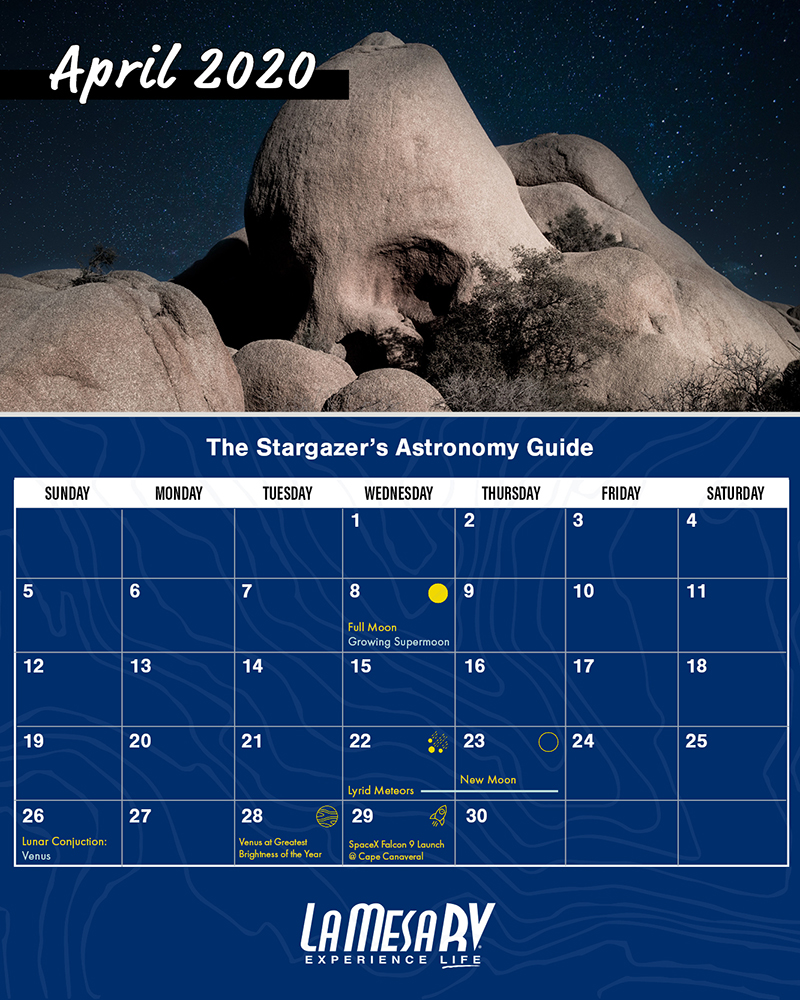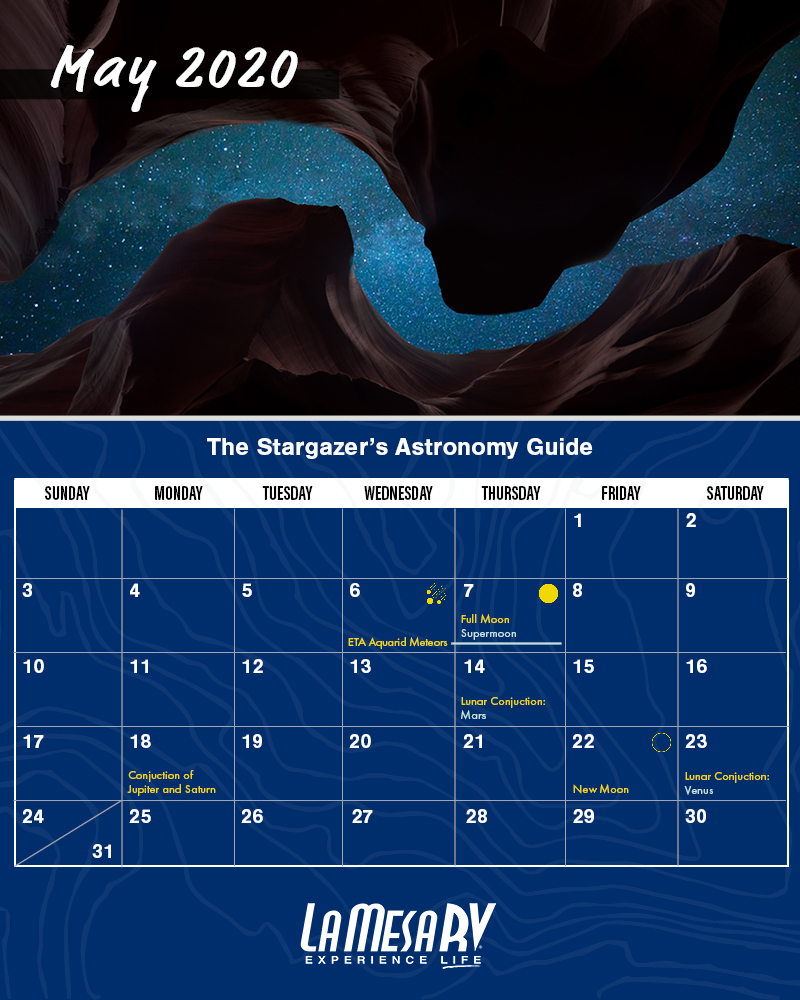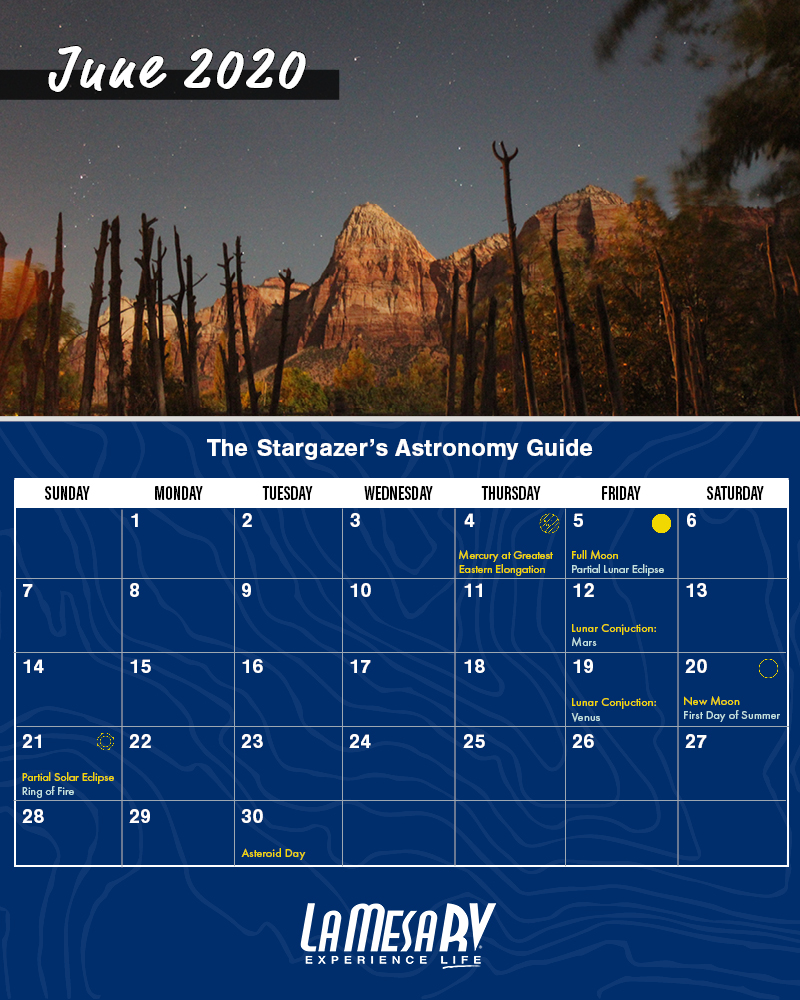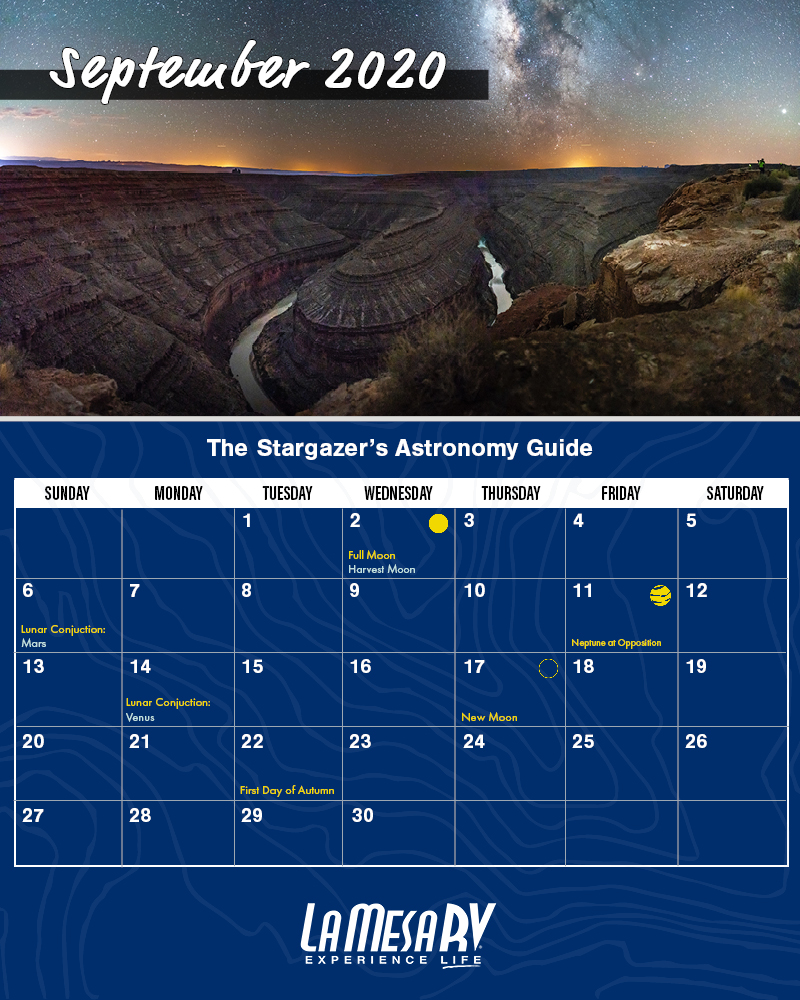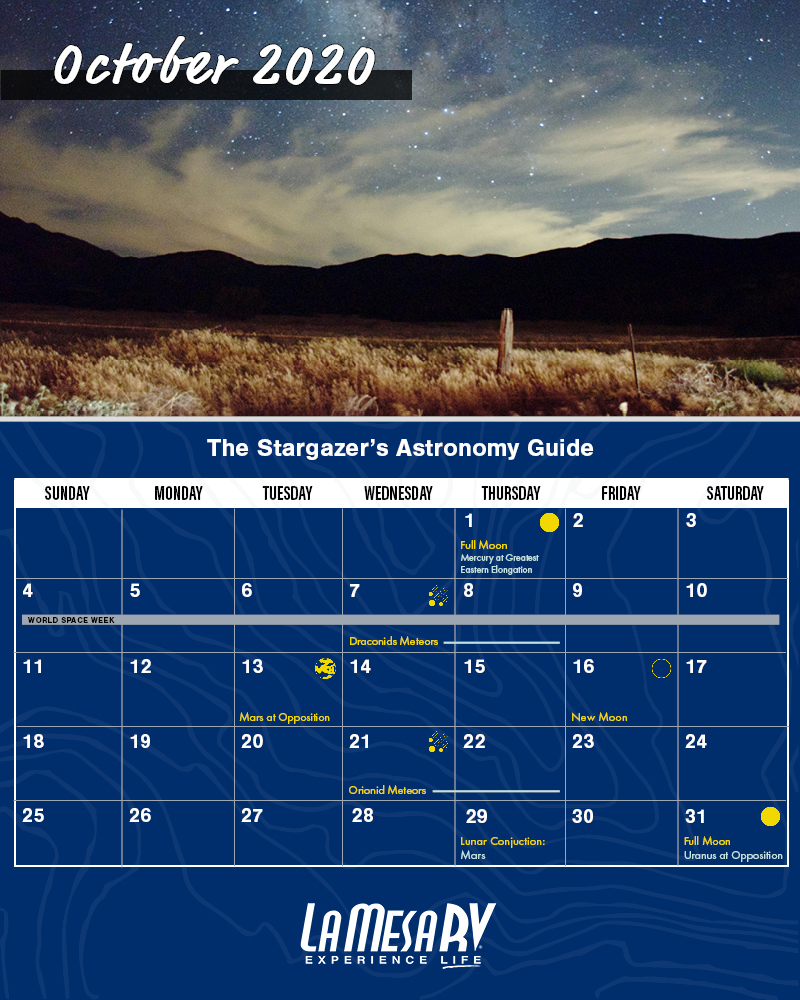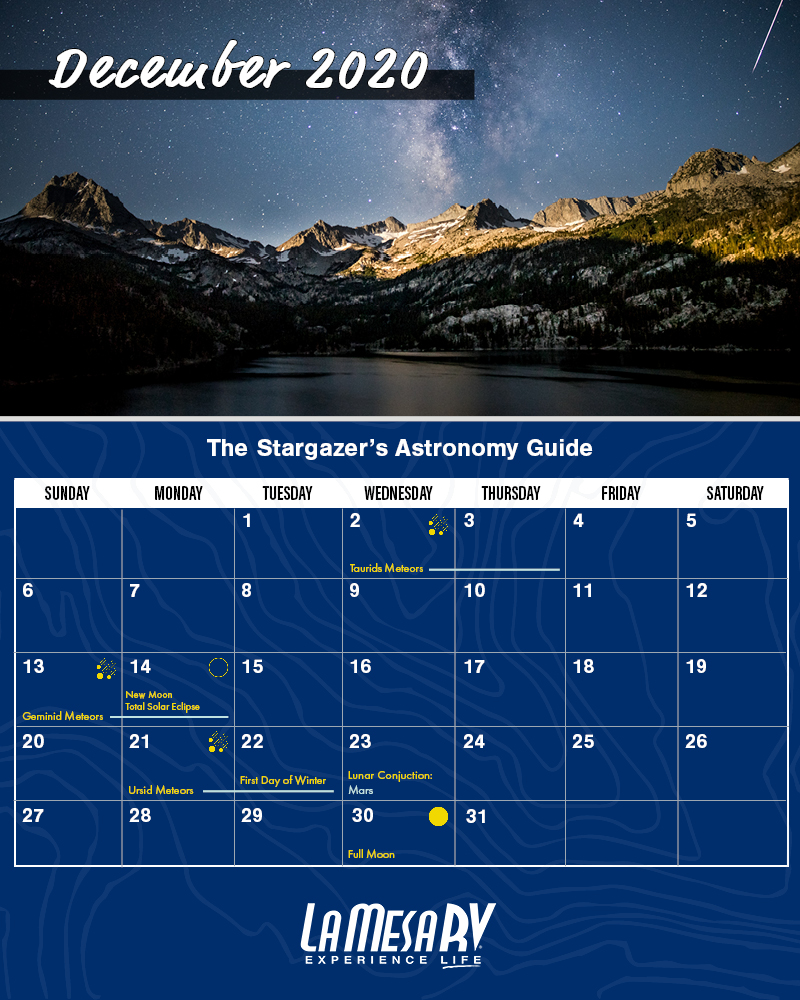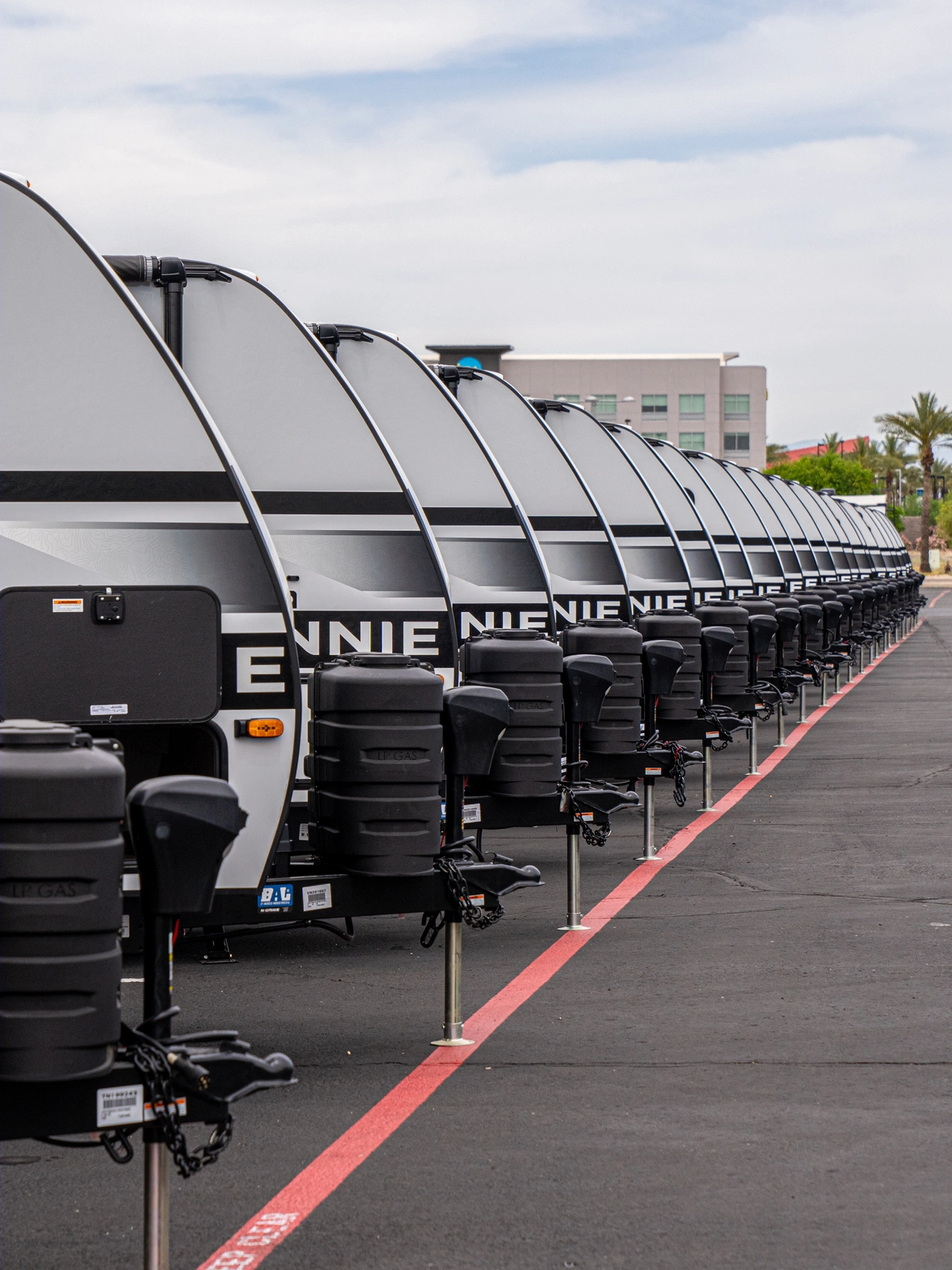As we continue to hunker down to stay safe during these unprecedented times, we've made it our mission to help you make the most out of your RV lifestyle. As many stargazers may know, some of the greatest adventures are after-dark! To help you keep track of the brightest moments to come in 2020, we're bringing you the camper's ultimate calendar to skywatching events. From meteor showers to rare lunar events, read on to start planning your next RV getaway beneath the night skies! After all, there is no better way to escape everyday troubles than beneath the peace and quiet of celestial wonder. You can scroll down to July's calendar to start planning your stargazing adventures for the remainder of 2020.
THE RVER'S COMPLETE STARGAZING CALENDAR | 2020
EVENT KEY:
????: Full Moon | ????: New Moon | ????: Launch | ????: Planetary Event | ????: Must-See Meteor/Lunar Event
APRIL 2020 || VENUS' BRIGHTEST MONTH
???? Apr 8: Full Moon phase (Super Pink Moon) - Biggest Full Moon of the Year
A supermoon occurs when the full moon coincides with the closest approach to Earth's orbit. This phenomenon creates the appearance of a brighter and closer moon than normal. Though the difference is difficult to tell with the naked eye, we highly recommend enjoying the view with a pair of binoculars! This is the third of four supermoons in 2020. While the full moon is always a stunning sight to enjoy with a set of binoculars, the bright lunar illumination can make it difficult for stargazing. Full moon events are best enjoyed during moon rises. Take the little ones on brightly lit camping trips and of course, don't forget to howl at the moon!
Did You Know? -- Early Native American tribes coined this full moon as the "Full Pink Moon" because it marked the appearance of Moss Pink Flora (wild ground phlox), one of the first spring flowers of the season.
???? Apr 22: Earth Day
Where would we be without the wonder of the stars to illuminate our greatest travel goals? Advocate for clear skies and celebrate clean living for people and mother earth alike! This global celebration was first established in 1970.
???? Apr 22-23: Lyrid Meteors
A typical meteor shower known as Lyrids, typically produces 20 meteors per hour at its peak. This shower has been produced by dust particles left by the comet C/1861 G1 Thatcher, first discovered in 1861.
???? Apr 23: New Moon Phase
Located on the same side of the Earth as the sun, the moon will not be visible in the night sky. With no moonlight to interfere, this makes for the best time to observe faint celestial views, such as galaxies, star clusters, and shooting stars.
???? Apr 26: Lunar conjunction with Venus
A waxing crescent moon will make a close approach to the planet, Venus in the evening sky. The conjunction will occur at 11:23 am EDT, while the pair will still appear close in the evenings before and after this date. You can catch the close pair above the southwestern horizon after sunset.
???? Apr 28: Venus' Brightest Evening
Venus shines brightly as the "evening star". From the view of Washington, this celestial event will be exceptionally well placed and prominent to enjoy. Venus will reach peak altitude at 45 degrees above the horizon at sunset.
???? Apr 29: Falcon 9 Rocket Launch @ Cape Canaveral Air Force Station, Florida
A Space X Falcon 9 rocket will launch the U.S. Air Force's third-generation navigation satellite, designated GPS 3 SV03 for the Global Positioning System. Lift-off will be at the Cape Canaveral Air Force Station in Florida.
MAY 2020 || SECOND SUPER MOON OF THE YEAR
???? May 6-7: ETA Aquarid Meteors
An above-average meteor shower, the ETA Aquarids can produce up to 60 meteors per hour at its peak. Most activity can be seen in the southern hemisphere. In the northern hemisphere, the meteor rate can reach up to 30 per hour. This meteor shower is produced by the dust particles left behind by the comet Halley, which has been observed since ancient times. This shower runs annually from April 19th to May 28th, peaking this year on the night of May 6th and the morning of May 7th. Keep in mind, the nearly full moon may make it difficult to catch meteors, so binoculars (or a telescope) are highly recommended. Meteors will radiate from the constellation Aquarius but can appear anywhere in the sky. Be sure to set up in a dark location (avoid light pollution) after midnight. Patient stargazers will still have a chance to catch some of the brightest meteors as they fall from the skies.
???? May 7: Full (Flower) Moon Phase
Located on the opposite side of the earth as the sun, the full moon will be completely illuminated. This phase will occur at 10:45 UTC. While the full moon is always a stunning sight to enjoy with a set of binoculars, the bright lunar illumination can make it difficult for stargazing. Full moon events are best enjoyed during moon rises.
Did You Know? -- Early Native American tribes coined this full moon as the "Full Flower Moon" because it marked the time of year in that Spring flowers bloom in abundance. This is the last of the four supermoon phases in 2020.
???? May 12: Lunar conjunction with Jupiter and Saturn
The waning gibbous moon can be seen huddled with Jupiter and Saturn in the predawn skies. Lunar conjunction with Jupiter will occur at 5:41 am (EDT), followed by conjunction with Saturn at 2:11 pm (EDT).
???? May 14: Lunar conjunction with Mars
The last-quarter moon makes a close approach to the Red Planet, Mars. Lunar conjunction will occur at 10:02 pm (EDT). Look toward the southeastern horizon before sunrise to enjoy the sight!
???? May 22: New Moon Phase
Located on the same side of the Earth as the sun, the moon will not be visible in the night sky. With no moonlight to interfere, this makes for the best time to observe faint celestial views, such as galaxies, star clusters, and shooting stars.
JUNE 2020 || VENUS' BRIGHTEST MONTH
???? Jun 4: Mercury at greatest eastern elongation
This is a great night to observe Mercury at its highest point above the horizon in the evening sky. Look for the planet low in the western sky just after sunset. Don't forget your binoculars for this one!
???? Jun 5: Full (Strawberry) Moon Phase
The Moon will be located on the opposite side of the Earth as the Sun and its face will be fully illuminated. This phase will occur at 19:12 UTC. While the full moon is always a stunning sight to enjoy with a set of binoculars, the bright lunar illumination can make it difficult for stargazing. Full moon events are best enjoyed during moon rises.
Did You Know? -- Early Native American tribes coined this full moon as the "Full Strawberry Moon" because it marked the time of year to gather ripening fruit. It also coincides with the peak of the strawberry harvesting season. This moon is also known as the Full Rose Moon and the Full Honey Moon.
???? Jun 5: Penumbral Lunar Eclipse
This event occurs when the Moon passes through the Earth's partial shadow (penumbra). During this type of eclipse the Moon will darken slightly but not completely. The eclipse will be visible throughout most of Europe, Africa, Asia, Australia, the Indian Ocean, and Australia. This event will occur at 1:45 p.m. EST (1745 GMT), lasting for 3 hours and 18 minutes.
???? Jun 5: Jupiter at opposition
This is a great evening to observe the planet Jupiter, as it will be at its closest to Earth and fully illuminated by the Sun. If you have a decent pair of binoculars or a small telescope, you may be able to catch some of Jupiter's moons!
???? Jun 8: Lunar conjunction with Jupiter and Saturn
The waning gibbous moon will form a small triangle with Jupiter and Saturn in the morning sky. It will be in conjunction with Jupiter at 1:21 p.m. EDT (1721 GMT), followed closely by conjunction with Saturn about 9 hours later at 10:12 p.m. EDT (0212 GMT on June 9).
???? Jun 12: Lunar conjunction with Mars
Just a day before reaching the last quarter phase, the moon will make a close approach to Mars in the predawn sky. The pair will be in conjunction at 7:55 p.m. EDT (2355 GMT), but they will be below the horizon for skywatchers in the U.S. at that time. Use your binoculars to catch them above the southeastern horizon for a few hours before sunrise.
???? Jun 19: Lunar conjunction with Venus
The one-day-old moon will make a close approach to Venus in the evening sky. It will be in conjunction with Venus at 4:53 EDT (0853 GMT). Look to the eastern horizon just before sunrise to catch the view!
???? Jun 20: First Day of Summer, Summer Solstice (21:44 UTC)
Happy Solstice! Today marks the first day of summer in the Northern Hemisphere and the first day of Winter in the Southern Hemisphere. This also marks the longest day of daylight in the Northern Hemisphere.
???? Jun 21: New Moon Phase
Located on the same side of the Earth as the sun, the moon will not be visible in the night sky. With no moonlight to interfere, this makes for the best time to observe faint celestial views, such as galaxies, star clusters, and shooting stars.
???? Jun 21: Annular Solar Eclipse "Ring of Fire"
This event occurs when the Moon is too far away from the Earth to completely cover the Sun. This results in a ring of light around the darkened Moon. The path of the eclipse will begin in central Africa and travel through Saudi Arabia, northern India, and southern China before ending in the Pacific Ocean. A partial eclipse will be visible throughout most of eastern Africa, the Middle East, and southern Asia.
Jun 30: International Asteroid Day
On June 30, 1908, the most harmful known asteroid-related event in recent history (known as the Siberian Tunguska) took place. Today, the United Nations has proclaimed the event be observed globally on June 30th every year in its resolution, which is now known as Asteroid Day. This day is observed to raise awareness about asteroids and what can be done to protect the Earth, its families, communities, and future generations from a catastrophic event.
JULY 2020 || JUPITER AND SATURN'S BRIGHTEST MONTH
???? Jul 5: Full (Buck) Moon Phase
The Moon will be located on the opposite side of the Earth as the Sun and its face will be fully illuminated. This phase occurs at 04:44 UTC. While the full moon is always a stunning sight to enjoy with a set of binoculars, the bright lunar illumination can make it difficult for stargazing. Full moon events are best enjoyed during moon rises.
Did You Know? -- Early Native American tribes coined this full moon as the "Full Buck Moon" because it marked the time of year that the male buck deer would begin to grow new antlers. This moon is also known as the Full Thunder Moon and the Full Hay Moon.
???? Jul 5: Partial lunar eclipse "Thunder Moon" Eclipse
A penumbral lunar eclipse occurs when the Moon passes through the Earth's partial shadow, or penumbra. The Moon will darken slightly but not completely. The eclipse will be visible throughout most of North America, South America, the eastern Pacific Ocean, the western Atlantic Ocean, and extreme western Africa. This lunar eclipse will be visible from the Americas to parts of Africa and Antarctica. It will begin passing through Earth's shadow on July 4th at 11:07 p.m. EST (0307 GMT on July 5), and the eclipse will last for 2 hours and 45 minutes.
???? Jul 14: Jupiter at opposition
The giant planet will be at its closest approach to Earth and its face will be fully illuminated by the Sun. It will be brighter than any other time of the year and will be visible all night long. This is the best time to view and photograph Jupiter and its moons. A medium-sized telescope should grant visibility to some of the details in Jupiter's cloud bands. A good pair of binoculars will allow you to see Jupiter's four largest moons, which will appear as bright dots on either side of the planet.
???? Jul 17: Atlas V Rocket Launch @ Cape Canaveral Air Force Station, Florida
NASA's Mars 2020 rover will launch for the Red Planet tonight! It will lift off on a United Launch Alliance Atlas V rocket from Cape Canaveral Air Force Station in Florida.
???? Jul 20: New Moon Phase
Located on the same side of the Earth as the sun, the moon will not be visible in the night sky. With no moonlight to interfere, this makes for the best time to observe faint celestial views, such as galaxies, star clusters, and shooting stars.
???? Jul 20: Saturn at opposition
The ringed planet will be at its closest approach to Earth and its face will be fully illuminated by the Sun. It will be brighter than any other time of the year and will be visible all night long. This is the best time to view and photograph Saturn and its moons. A medium-sized or larger telescope will allow you to see Saturn's rings and a few of its brightest moons.
???? Jul 22: Mercury at greatest western elongation
This evening offers the best opportunity to enjoy a bright view of Mercury. The planet will be at its highest point above the horizon in the morning sky. For the best skywatching experience, be sure to look for the planet low in the eastern sky just before sunrise.
???? Jul 28-29: Delta Aquarids meteors
The Delta Aquarids is an average shower that can produce up to 20 meteors per hour at its peak. It is produced by debris left behind by comets Marsden and Kracht. The shower runs annually from July 12th to August 23rd. It peaks this year on the night of July 28th and the morning of July 29th. The second quarter moon will block many of the fainter meteors this year. If you are patient, you should still be able to catch a few of the brighter ones. The best viewing opportunity will be from a dark location after midnight. Meteors will radiate from the constellation Aquarius but can appear anywhere in the sky.
AUGUST 2020 || SUMMER BENEATH THE STARS
???? Aug 3: Full (Sturgeon) Moon Phase
The Moon will be located on the opposite side of the Earth as the Sun and its face will be fully illuminated. This phase occurs at 15:59 UTC. While the full moon is always a stunning sight to enjoy with a set of binoculars, the bright lunar illumination can make it difficult for stargazing. Full moon events are best enjoyed during moon rises.
Did You Know? -- Early Native American tribes coined this full moon as the "Full Sturgeon Moon" because it marked the time of year that the large sturgeon fish of the Great Lakes and other major lakes are more easily caught.
???? Aug 9: Lunar conjunction with Mars
The waning, gibbous moon will make a close approach to the Red Planet in the early morning sky. It will be in conjunction with Mars at 4 a.m. EDT (0800 GMT).
???? Aug 12-13: Perseid Meteors
The Perseids is one of the best meteor showers to observe, producing up to 60 meteors per hour at its peak. It is produced by comet Swift-Tuttle, which was discovered in 1862. The Perseids are famous for producing a large number of bright meteors. The shower runs annually from July 17th to August 24th. It peaks this year on the night of August 12th and the morning of August 13th. The second quarter moon will block out some of the fainter meteors this year, but the Perseids are so bright and numerous that it should still be a good show. The best viewing opportunity will be from a dark location after midnight. Meteors will radiate from the constellation Perseus but can appear anywhere in the sky.
???? Aug 13: Venus at greatest Western elongation
The planet Venus reaches greatest eastern elongation of 45.8 degrees from the Sun. This is the best time to view Venus since it will be at its highest point above the horizon in the morning sky. Look for the bright planet in the eastern sky before sunrise.
???? Aug 19: New Moon Phase
Located on the same side of the Earth as the sun, the moon will not be visible in the night sky. With no moonlight to interfere, this makes for the best time to observe faint celestial views, such as galaxies, star clusters, and shooting stars. The third new moon in a season with four new moons is known as a "black moon." A black moon can also be the second new moon in a single calendar month.
???? Aug 28-29: Lunar conjunction with Venus
The waxing gibbous moon will be in conjunction with Jupiter at 9:35 p.m. EDT (0235 GMT on Aug. 29). The following day, it will be in conjunction with Saturn at 12:32 p.m. EDT (1632 GMT). Look for the trio in the evening sky.
???? Aug 31: Atlas V Rocket Launch @ Wallops Flight Facility, Virginia
Northrop Grumman's Cygnus NG-14 cargo spacecraft will launch to the International Space Station on an Antares rocket. It will lift off from NASA's Wallops Flight Facility in Virginia.
SEPTEMBER 2020 || NEPTUNE'S BRIGHTEST MONTH
???? Sep 2: Full (Harvest) Moon Phase
The Moon will be located on the opposite side of the Earth as the Sun and its face will be fully illuminated. This phase occurs at 05:23 UTC. While the full moon is always a stunning sight to enjoy with a set of binoculars, the bright lunar illumination can make it difficult for stargazing. Full moon events are best enjoyed during moon rises.
Did You Know? -- Early Native American tribes coined this full moon as the "Full Corn Moon" because it marked the time of year that corn would be harvested.
???? Sep 6: Lunar conjunction with Mars
The waning gibbous moon will make a close approach to the Red Planet in the early morning sky. It will be in conjunction with Mars at 12:46 a.m. EDT (0446 GMT).
???? Sep 11: Neptune at opposition
The blue giant planet will be at its closest approach to Earth and its face will be fully illuminated by the Sun. It will be brighter than any other time of the year and will be visible all night long. This is the best time to view and photograph Neptune. Due to its extreme distance from Earth, it will only appear as a tiny blue dot in all but the most powerful telescopes.
???? Sep 14: Lunar conjunction with Venus
The waning crescent moon will be in conjunction with Venus, the "morning star," at 12:44 a.m. EDT (0444 GMT). Look for the pair above the eastern horizon before dawn.
???? Sep 17: New Moon Phase
Located on the same side of the Earth as the sun, the moon will not be visible in the night sky. With no moonlight to interfere, this makes for the best time to observe faint celestial views, such as galaxies, star clusters, and shooting stars.
???? Sep 22: First Day of Fall, Autumnal Equinox (13:31 UTC)
The September equinox occurs at 13:31 UTC. The Sun will shine directly on the equator and there will be nearly equal amounts of day and night throughout the world. This is also the first day of fall (autumnal equinox) in the Northern Hemisphere and the first day of spring (vernal equinox) in the Southern Hemisphere.
???? Sep 25: Lunar conjunction with Jupiter and Saturn
The waxing, gibbous moon will be in conjunction with Jupiter at 2:48 a.m. EDT (0648 GMT). The following day, it will be in conjunction with Saturn at 4:38 p.m. EDT (2038 GMT). Look for the trio in the evening sky.
OCTOBER 2020 || MARS' BRIGHTEST MONTH
???? Oct 1: Full (Hunters) Moon Phase
The Moon will be located on the opposite side of the Earth as the Sun and its face will be fully illuminated. This phase occurs at 21:06 UTC. While the full moon is always a stunning sight to enjoy with a set of binoculars, the bright lunar illumination can make it difficult for stargazing. Full moon events are best enjoyed during moon rises.
Did You Know? -- Early Native American tribes coined this full moon as the "Full Hunters Moon" because it marked the time of year that the leaves are falling and the game is fat and ready to hunt. This moon has also been known as the Travel Moon and the Blood Moon. This moon is also known as the Harvest Moon. The Harvest Moon is the full moon that occurs closest to the September equinox each year.
???? Oct 1: Mercury at greatest eastern elongation
This is the best time to view Mercury since it will be at its highest point above the horizon in the evening sky. Look for the planet low in the western sky just after sunset.
Oct 4-10: World Space Week
World Space Week is observed in over 90 nations throughout the world. This even is officially defined as, "an international celebration of science and technology, and their contribution to the betterment of the human condition".
???? Oct 7: Draconids Meteors
The Draconids is a minor meteor shower producing only about 10 meteors per hour. It is produced by dust grains left behind by comet 21P Giacobini-Zinner, which was first discovered in 1900. The Draconids is an unusual shower in that the best viewing is during early evening instead of early morning, like most other showers. The shower runs annually from October 6th - 10th and peaks this year on the night of the 7th. The second quarter moon will ensure dark skies in the early evening for what should be a good show. The best viewing opportunity will be in the early evening from a dark location far away from city lights. Meteors will radiate from the constellation Draco but can appear anywhere in the sky.
???? Oct 13: Mars at Opposition
The red planet will be at its closest approach to Earth and its face will be fully illuminated by the Sun. It will be brighter than any other time of the year and will be visible all night long. This is the best time to view and photograph Mars. A medium-sized telescope will allow you to see some of the dark details on the planet's orange surface.
???? Oct 16: New Moon Phase
Located on the same side of the Earth as the sun, the moon will not be visible in the night sky. With no moonlight to interfere, this makes for the best time to observe faint celestial views, such as galaxies, star clusters, and shooting stars.
???? Oct 21-22: Orionid Meteors
The Orionids is an average shower producing up to 20 meteors per hour at its peak. It is produced by dust grains left behind by comet Halley, which has been known and observed since ancient times. The shower runs annually from October 2nd to November 7th. It peaks this year on the night of October 21st and the morning of October 22nd. The waxing crescent moon will set before midnight, leaving dark skies for what should be a good show. The best viewing opportunity will be from a dark location after midnight. Meteors will radiate from the constellation Orion but can appear anywhere in the sky.
???? Oct 30: Lunar conjunction with Mars
The waxing gibbous moon will be in conjunction with Mars at 12:16 p.m. EDT (0325 GMT). Look for the pair above the eastern horizon after sunset.
???? Oct 30: Falcon 9 Rocket Launch @ Cape Canaveral Air Force Station, Florida
A SpaceX Falcon 9 rocket will launch a Dragon cargo resupply mission (CRS-21) to the International Space Station. It will lift off from Cape Canaveral Air Force Station in Florida.
???? Oct 31: Full Moon phase (Blue Moon)
The Moon will be located on the opposite side of the Earth as the Sun and its face will be fully illuminated. This phase occurs at 14:51 UTC. Since this is the second full moon in the same month, it is sometimes referred to as a Blue Moon. This rare calendar event only occurs every few months, giving rise to the term "once in a blue moon".
???? Oct 31: Uranus at Opposition
The blue-green planet will be at its closest approach to Earth and its face will be fully illuminated by the Sun. It will be brighter than any other time of the year and will be visible all night long. This is the best time to view Uranus. Due to its distance, it will only appear as a tiny blue-green dot in all but the most powerful telescopes.
NOVEMBER 2020 || THE MONTH OF METEORS
???? Nov 4-5: Taurids Meteors
The Taurids is a long-running minor meteor shower producing only about 5-10 meteors per hour. It is unusual in that it consists of two separate streams. The first is produced by dust grains left behind by Asteroid 2004 TG10. The second stream is produced by debris left behind by Comet 2P Encke. The shower runs annually from September 7th to December 10th. It peaks this year on the night of November 4th. The first quarter moon will block out all but the brightest meteors this year. If you are patient, you may still be able to catch a few good ones. Best viewing will be just after midnight from a dark location far away from city lights. Meteors will radiate from the constellation Taurus but can appear anywhere in the sky.
???? Nov 10: Mercury at greatest western elongation
This evening offers the best opportunity to enjoy a bright view of Mercury. The planet will be at its highest point above the horizon in the morning sky. For the best skywatching experience, be sure to look for the planet low in the eastern sky just before sunrise.
???? Nov 12: Lunar conjunction with Venus
The waning crescent moon will be in conjunction with Venus, the "morning star," at 4:30 p.m. EST (2130 GMT). Look for the pair above the eastern horizon before dawn.
???? Nov 15: New Moon Phase
Located on the same side of the Earth as the sun, the moon will not be visible in the night sky. With no moonlight to interfere, this makes for the best time to observe faint celestial views, such as galaxies, star clusters, and shooting stars.
???? Nov 17-18: Leonid Meteors
The Leonids is an average shower, producing up to 15 meteors per hour at its peak. This shower is unique in that it has a cyclonic peak about every 33 years where hundreds of meteors per hour can be seen. That last of these occurred in 2001. The Leonids is produced by dust grains left behind by comet Tempel-Tuttle, which was discovered in 1865. The shower runs annually from November 6th - 30th. It peaks this year on the night of the 17th and morning of the 18th. The crescent moon will set early in the evening leaving dark skies for what should be an excellent show. The best viewing opportunity will be from a dark location after midnight. Meteors will radiate from the constellation Leo but can appear anywhere in the sky.
???? Nov 19: Lunar conjunction with Jupiter and Saturn
The waxing crescent moon will be in conjunction with Jupiter at 3:57 a.m. EST (0857 GMT). Shortly afterward, it will be in conjunction with Saturn at 9:51 a.m. EST (1451 GMT). Look for the trio in the evening sky.
???? Nov 25: Lunar conjunction with Mars
The waxing gibbous moon will be in conjunction with Mars at 2:46 p.m. EST (1946 GMT). Look for the pair above the eastern horizon after sunset.
???? Nov 30: Full Moon Phase
The Moon will be located on the opposite side of the Earth as the Sun and its face will be fully illuminated. This phase occurs at 09:32 UTC. While the full moon is always a stunning sight to enjoy with a set of binoculars, the bright lunar illumination can make it difficult for stargazing. Full moon events are best enjoyed during moon rises.
Did You Know? -- Early Native American tribes coined this full moon as the "Full Beaver Moon" because it marked the time of year to set the beaver traps before the swamps and rivers froze. It is also known as the Full Frosty Moon.
???? Nov 30: Penumbral Lunar Eclipse
A penumbral lunar eclipse occurs when the Moon passes through the Earth's partial shadow (penumbra). During this type of eclipse the Moon will darken slightly but not completely. The eclipse will be visible throughout most of North America, the Pacific Ocean, and northeastern Asia including Japan.
DECEMBER 2020 || END-OF-YEAR ECLIPSE
???? Dec 13-14: Geminid Meteors
The Geminids are the king of meteor showers. They are considered by many to be the best shower in the heavens, producing up to 120 multicolored meteors per hour at its peak. It is produced by debris left behind by an asteroid known as 3200 Phaethon, which was discovered in 1982. The shower runs annually from December 7th - 17th. It peaks this year on the night of the 13th and morning of the 14th. The morning of the 15th could also be nearly as active this year. The nearly new moon will ensure dark skies for what should be an excellent show. The best viewing opportunity will be from a dark location after midnight. Meteors will radiate from the constellation Gemini but can appear anywhere in the sky.
???? Dec 14: New Moon Phase
Located on the same side of the Earth as the sun, the moon will not be visible in the night sky. With no moonlight to interfere, this makes for the best time to observe faint celestial views, such as galaxies, star clusters, and shooting stars.
???? Dec 14: Total Solar Eclipse
A total solar eclipse occurs when the moon completely blocks the Sun, revealing the Sun's beautiful outer atmosphere known as the corona. The path of totality will only be visible in parts of southern Chile and southern Argentina. A partial eclipse will be visible in most parts of southern South America, the southeastern Pacific Ocean, and the southern Atlantic Ocean.
[?] Dec 21: Winter Solstice (10:02 UTC)
The December solstice occurs at 10:02 UTC. The South Pole of the earth will be tilted toward the Sun, which will have reached its southernmost position in the sky and will be directly over the Tropic of Capricorn at 23.44 degrees south latitude. This is the first day of winter (winter solstice) in the Northern Hemisphere and the first day of summer (summer solstice) in the Southern Hemisphere.
???? Dec 21: Rare Conjunction of Jupiter and Saturn
This rare conjunction of these two planets is known as a great conjunction. The last great conjunction occurred in the year 2000. The two bright planets will appear only 7 arc minutes of each other in the night sky. They will be so close that they will appear to make a bright double planet. Look to the west just after sunset for this impressive and rare planetary pair.
???? Dec 21-22: Ursid Meteors
The Ursids is a minor meteor shower producing about 5-10 meteors per hour. It is produced by dust grains left behind by comet Tuttle, which was first discovered in 1790. The shower runs annually from December 17th -25th. It peaks this year on the night of the 21st and morning of the 22nd. The first quarter moon should set just after midnight leaving dark skies for what could be a good show. The best viewing opportunity will be just after midnight from a dark location far away from city lights. Meteors will radiate from the constellation Ursa Minor but can appear anywhere in the sky.
???? Dec 30: Full Moon Phase
The Moon will be located on the opposite side of the Earth as the Sun and its face will be fully illuminated. This phase occurs at 03:30 UTC. While the full moon is always a stunning sight to enjoy with a set of binoculars, the bright lunar illumination can make it difficult for stargazing. Full moon events are best enjoyed during moon rises.
Did You Know? -- Early Native American tribes coined this full moon as the "Full Cold Moon" because it marked the time of year when the cold winter air settles in and the nights become long and dark. This moon has also been known as the Full Long Nights Moon and the Moon Before Yule.
TOP TRAVEL SPOTS FOR STARGAZING CAMPERS
Are you looking for the perfect parking spot to watch the stars? To help you map out your next stargazing road trip, we've rounded up a list of the very best dark sky campsites and parks for stargazers, along with the very best observatories across America. Whether wishing to catch a celestial sight with your personal binoculars or through an astronomer's telescope, this interactive map charts out the very best destinations to enjoy the night skies. Read on below for the full destination list!
POPULAR RV CAMPSITES AND DARK SKY PARKS FOR STARGAZERS
- Apache RV Park, New Mexico
- Big Pine Key Fishing Lodge, Big Pine Key, Florida
- Black Rock Campground, Joshua Tree National Park, California
- Borrego Palm Canyon Campground, Borrego Springs, California
- Casini Ranch Family Campground, California
- Clayton Lake State Park, New Mexico
- Cosmic Campground, New Mexico
- Furnace Creek Ranch, Death Valley National Park
- Gilbert Bay Campground, Kitt Peak National Observatory, Arizona
- Parashant National Monument, Arizona
SKY WATCHING DESTINATIONS: TOP OBSERVATORIES ACROSS AMERICA
- Apache RV Park, New Mexico
- Big Pine Key Fishing Lodge, Big Pine Key, Florida
- Black Rock Campground, Joshua Tree National Park, California
- Borrego Palm Canyon Campground, Borrego Springs, California
- Casini Ranch Family Campground, California
- Clayton Lake State Park, New Mexico
- Cosmic Campground, New Mexico
- Furnace Creek Ranch, Death Valley National Park
- Gilbert Bay Campground, Kitt Peak National Observatory, Arizona
- Parashant National Monument, Arizona
If you're a sky-watching beginner looking for some pointers on how to make the most of your next stargazing trip, check out our RVer's Introductory Guide to Stargazing with REI. From safe practices to everything you'll need to pack for your adventure under the stars, this guide will help you prep for the perfect night.
